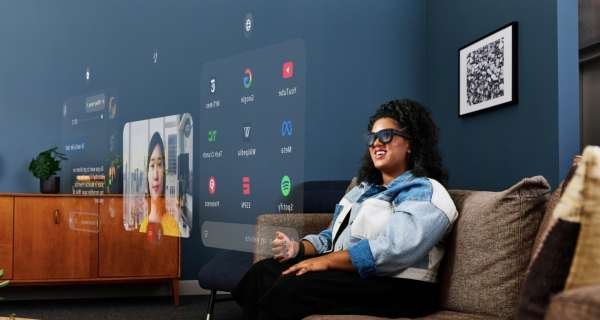Five years ago, we announced to the world that we were building AR glasses. We don’t think people should have to make the choice between a world of information at your fingertips and being present in the physical world around you.
That’s why today, we’re unveiling Orion, which we believe is the most advanced pair of AR glasses ever made. Orion bridges the physical and virtual worlds, putting people at the center so they can be more present, connected and empowered in the world.
Why Augmented Reality Glasses?
There are three primary reasons why AR glasses are key to unlocking the next great leap in human-oriented computing.
They enable digital experiences that are unconstrained by the limits of a smartphone screen. With large holographic displays, you can use the physical world as your canvas, placing 2D and 3D content and experiences anywhere you want.
They seamlessly integrate contextual AI that can sense and understand the world around you in order to anticipate and proactively address your needs.
They’re lightweight and great for both indoor and outdoor use, and they let people see each other’s face, eyes and expressions.
Five years ago, we announced to the world that we were building AR glasses. We don’t think people should have to make the choice between a world of information at your fingertips and being present in the physical world around you.
That’s why today, we’re unveiling Orion, which we believe is the most advanced pair of AR glasses ever made. Orion bridges the physical and virtual worlds, putting people at the center so they can be more present, connected and empowered in the world.
Why Augmented Reality Glasses?
There are three primary reasons why AR glasses are key to unlocking the next great leap in human-oriented computing.
They enable digital experiences that are unconstrained by the limits of a smartphone screen. With large holographic displays, you can use the physical world as your canvas, placing 2D and 3D content and experiences anywhere you want.
They seamlessly integrate contextual AI that can sense and understand the world around you in order to anticipate and proactively address your needs.
They’re lightweight and great for both indoor and outdoor use, and they let people see each other’s face, eyes and expressions.
That’s the north star our industry has been building towards: a product combining the convenience and immediacy of wearables with a large display, high-bandwidth input and contextualized AI in a form that people feel comfortable wearing in their daily lives.
The Evolution of Smart Glasses
Ray-Ban Meta glasses have demonstrated the power of giving people hands-free access to key parts of their digital lives from their physical ones. We can talk to a smart AI assistant, connect with friends and capture the moments that matter – all without ever having to pull out a phone.
Yet while Ray-Ban Meta opened up an entirely new category of display-less glasses super-charged by AI, the XR industry has long dreamt of true AR glasses – a product that combines the benefits of a large holographic display and personalized AI assistance in a comfortable, all-day wearable form factor. Orion rises to the challenge.
Groundbreaking AR Display in an Unparalleled Form
We’ve been hard at work for years to take the incredible spatial experiences afforded by VR and MR headsets and miniaturize the technology necessary to deliver those experiences in a pair of lightweight, stylish glasses.
Nailing the form factor, delivering holographic displays, developing compelling AR experiences, creating new human-computer interaction (HCI) paradigms – and doing it all in one cohesive product – is one of the most difficult challenges our industry has ever faced. It was so challenging that we thought we had less than a 10% chance of pulling it off successfully. Until now.
Orion is a feat of miniaturization – the components are packed down to a fraction of a millimeter. Dozens of innovations were required to get the design down to a contemporary form that you’d be comfortable wearing every day.
Orion has the largest field of view in the smallest AR glasses form to date. That field of view unlocks truly immersive use cases for Orion, from multitasking windows and big-screen entertainment to life-size holograms of people – all digital content that can seamlessly blend with your view of the physical world.














0 Comments